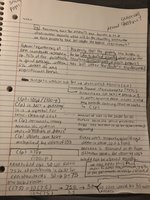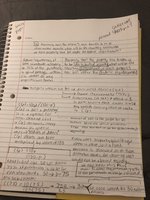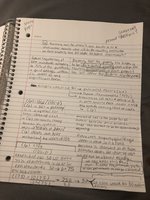You are using an out of date browser. It may not display this or other websites correctly.
You should upgrade or use an alternative browser.
You should upgrade or use an alternative browser.
Calculus Word Problem
- Thread starter Skh
- Start date
Otis
Elite Member
- Joined
- Apr 22, 2015
- Messages
- 4,592
Hello Skh. You reported percents for parts (a), (b) and (c). The word 'assessment' has different meanings; in this exercise, they're using the definition which means the tax itself. In other words, you need to report the dollar amount that each owner would pay toward covering the clean-up cost. That amount of tax is the same for all owners because we're told the "tax burden is to be distributed equally". Everyone's property and buildings differ in value, so if a fixed percent were to be assessed on those differing valuations instead, then the clean-up cost would not be shared equally.… (a) Assuming that the property tax burden is to be distributed equally, what will be the resulting assessment on each property tax bill under the federal requirements? …
You're treating C(p) as a percent, too. That's incorrect. Symbol C(p) is function notation for the total clean-up cost. We can tell that C(p) represents money because its given units are "millions of dollars". Therefore, do not multiply your C(p) values by 100.2. The cost, in millions of dollars, to reduce the pollutants in the lake to a given percentage p is estimated by the following formula (function):
C(p) = 10p/(100 - p)
The next issue is that you're using the decimal forms of the percents, in the formula for function C. That leads to answers that are way too small -- between $0.95 and $1.20 -- for parts (a) through (c). We need to read "given percentage p" to mean p%. For example, if we're talking about removing 75% of pollutants, then use p=75 when calculating C(p).
Note above that they wrote "reduce … to a given percentage". Well, if 75% of pollutants are removed, then 25% remain. We would then say pollutants have been reduced by 75% (not 'to') and reduced to 25%. Did they misspeak? Working part (a) both ways, I found that C(75) leads to a Whole dollar amount, but distributing C(25) evenly requires rounding plus additional adjustments to cover the entire clean-up without overcharging. (Also, we should expect the clean-up to cost tens of millions, not tens of thousands, of dollars.) Therefore, I think they ought to have made clear that C(p) is the total cost for reducing the pollutants by p%.
The cost (in millions of dollars) for removing 75% of pollutants is C(75).
Please ask for clarification, if you have any questions about what I wrote.
?
I think I understood everything you said. This is what I got when I rewrote it and applied it all for part a. Please let me know if anything looks off. Thank you for all the help and writing what I was doing wrong.Hello Skh. You reported percents for parts (a), (b) and (c). The word 'assessment' has different meanings; in this exercise, they're using the definition which means the tax itself. In other words, you need to report the dollar amount that each owner would pay toward covering the clean-up cost. That amount of tax is the same for all owners because we're told the "tax burden is to be distributed equally". Property values differ, so if a fixed percent were to be assessed on those differing valuations, instead, then the clean-up cost would not be shared equally.
You're treating C(p) as a percent, too. That's incorrect. Symbol C(p) is function notation for the total clean-up cost. We can tell that C(p) represents money because its given units are "millions of dollars". Therefore, do not multiply your C(p) values by 100.
The next issue is that you're using the decimal forms of the percents, in the formula for function C. That leads to answers that are way too small -- between $0.95 and $1.20 -- for parts (a) through (c). We need to read "given percentage p" to mean p%. For example, if we're talking about removing 75% of pollutants, then use p=75 when calculating C(p).
Note above that they wrote "reduce … to a given percentage". Well, if 75% of pollutants are removed, then 25% remain. We would then say pollutants have been reduced by 75% (not 'to') and reduced to 25%. Did they misspeak? Working part (a) both ways, I found that C(75) leads to a Whole dollar amount, but distributing C(25) evenly requires rounding plus additional adjustments to cover the entire clean-up without overcharging. (Also, we should expect the clean-up to cost tens of millions, not tens of thousands, of dollars.) Therefore, I think they ought to have made clear that C(p) is the total cost for reducing the pollutants by p%. So, the cost (in millions of dollars) for removing 75% of pollutants is:
C(75) = 10(75)/(100 - 75)
Please ask for clarification, if you have any questions about what I wrote.
?
Attachments
Otis
Elite Member
- Joined
- Apr 22, 2015
- Messages
- 4,592
Hi Skh. If you're concerned that the bottom of some images are cut off, they only appear that way. The image can be scrolled, or the view can be switched to full-screen.… not sure if [the attachment] came out clear enough …
Your new calculations and answer on part (a) look good.
If you need help with parts (d) or (e), please post your thoughts or work. Cheers
?








